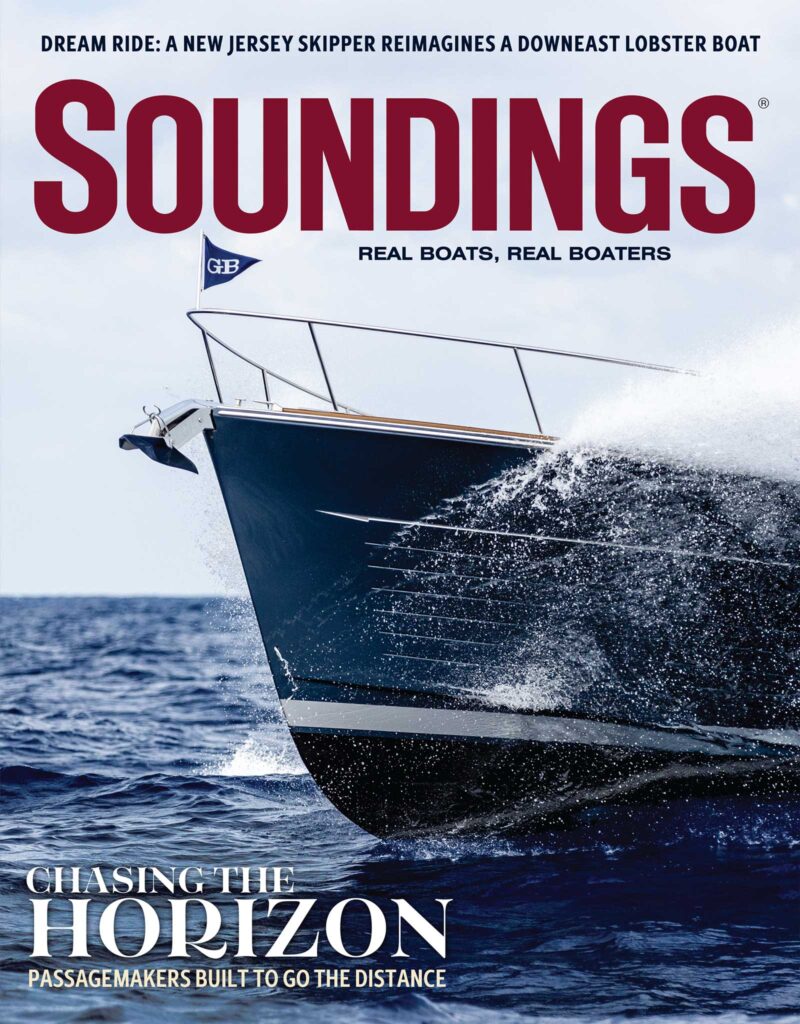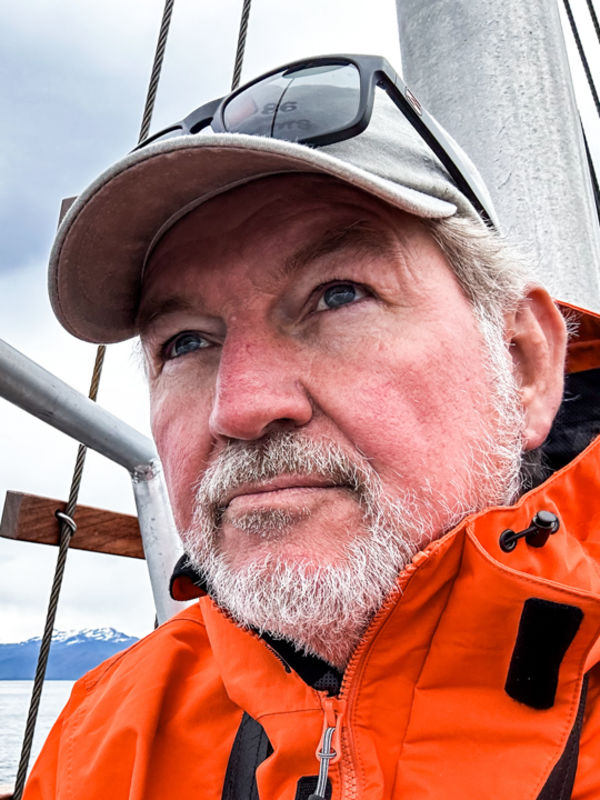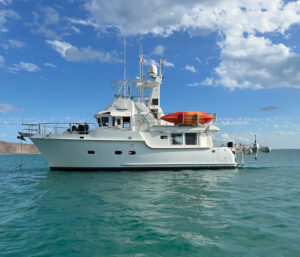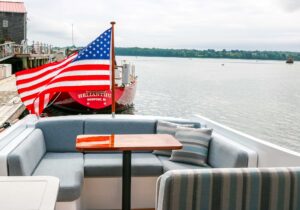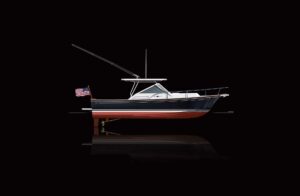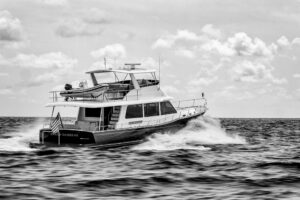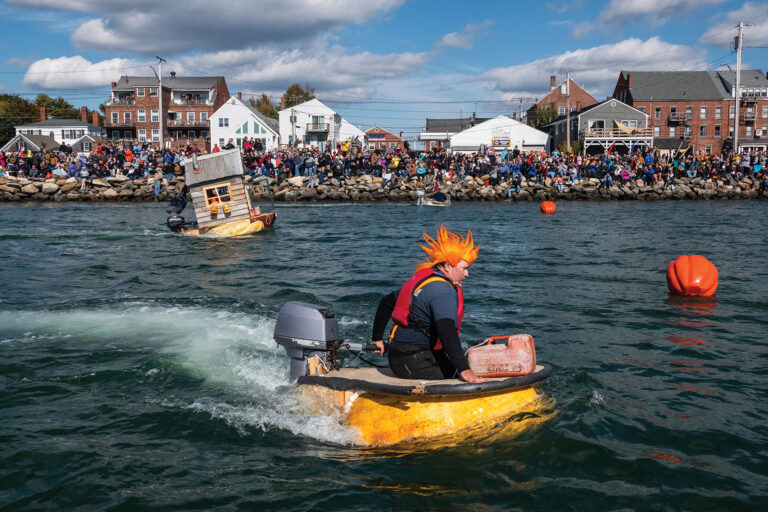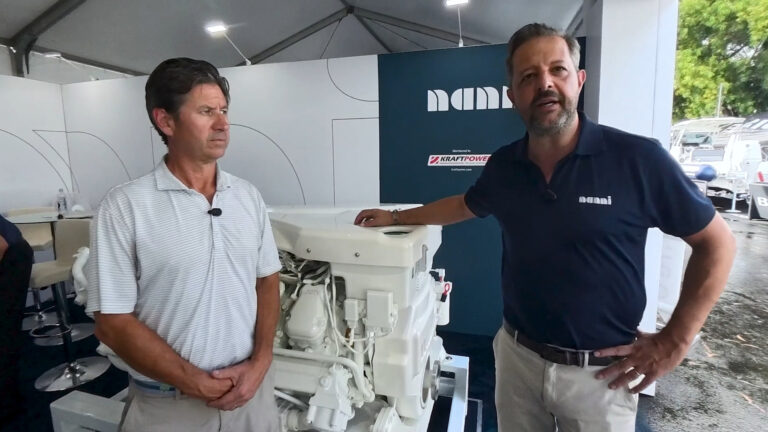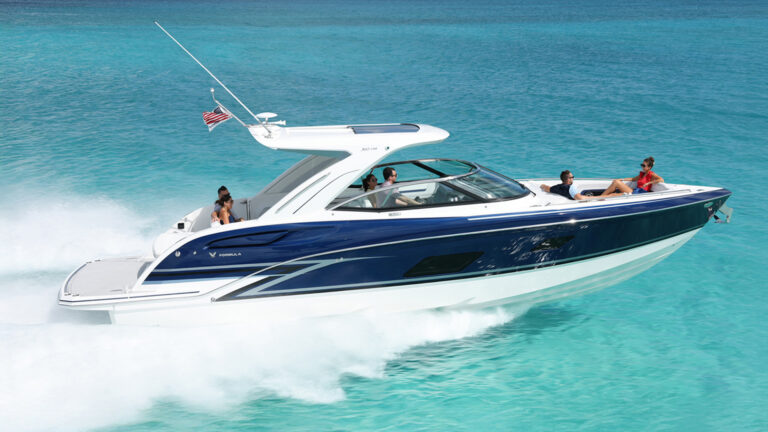While zipping across Charleston Harbor on the Zodiac X10CC, it occurred to me that Jacques Cousteau never had it this good.
Yes, the famous French oceanographer got to dive all the world’s most beautiful locations, and I did not, but he never got to drive a Zodiac like this. The French company’s latest model, which became available in the U.S. in January 2025, is a beast—a good kind of beast—and it’s nothing like the smaller Zodiacs that Cousteau had aboard his mothership Calypso.
I first crossed paths with the X10CC at the 2024 Fort Lauderdale International Boat Show where Zodiac Nautic Regional Sales Manager Ryan Jaco and Zodiac Nautic COO Tim March, who is in charge of the Americas for the brand, walked me through the boat. I was impressed, but there was a problem. I wanted to drive it, and the 33-footer, the largest Zodiac ever built, was sitting on a trailer.
Full disclosure is required here. I own a Zodiac, and I am a big Jacques Cousteau fan. I was fortunate to meet the man once, and when my wife wanted to adopt two cats, I acquiesced, on the condition that we name them Jacques and Calypso. It was Cousteau’s TV shows that turned me onto Zodiacs, and I’ve had my 16-foot, 5-inch Zodiac Pro 500 with its 50-hp Yamaha outboard for 15 years.
 Pim Van Hemmen
Pim Van HemmenBut the X10CC is twice as long as my RIB and has almost 20 times the horsepower. To drive it, March offered me a solution. If after the Lauderdale show I could fly from my home base in Maine to Charleston, South Carolina, he would trailer the boat from Zodiac’s U.S. base in Summerville, South Carolina, to a boat ramp and dunk it. But there was one caveat. It had to happen before January 9 when the boat, the first X10CC in the United States and only the second hull constructed, was being sent off to the Great Lakes.
Two months later, as a polar vortex drove nighttime temperatures in Charleston below freezing, March, Jaco and Zodiac’s Technical Director Alan Brocious met me with the X10CC on the Ashley River west of Charleston.
The X10CC is not at all like Jacques Cousteau’s Zodiacs. Those were flat-bottomed, tiller-steered models, and even though it’s technically a RIB and clearly has the Zodiac DNA, it’s not like Zodiac’s popular Open, Pro and Medline models. The X10CC is more of a hybrid, a combination of a traditional American center console and a RIB. Instead of the standard round tubes on Zodiacs’ other RIBs, the X10CC has a D-collar more commonly seen on the Coast Guard’s Defender models, except that the Zodiac’s collar is inflatable and not made of rigid polyethylene foam. By using an inflatable D-collar, the X10CC gains valuable space inside the hull, which negates one of the few drawbacks of a traditional RIB where the round tubes take up a good chunk of a boat’s beam. At the same time, the D-Collar retains all the advantages of an inflatable: lighter weight, safety, better fuel efficiency, more floatability and greater carrying capacity than a traditional fiberglass boat. The X10CC is rated for 20 passengers whereas similarly sized hard-sided boats might just carry 10.
 Pim Van Hemmen
Pim Van HemmenThe X10 CC is aimed at American boaters. She is a center console with walkaround decks, a large social area that can be converted to a sun pad on the bow, another large convertible social area on the stern, optional twin 450-hp V8 XTO Yamahas that give her a WOT of 60 knots, a forward cabin with a V-berth and head, tall bulwarks to keep passengers safely inside the boat, seating for three at the helm, and a cockpit bar/galley aft of the helm.
And the X10CC is highly configurable, so if an owner wants to focus on fishing, the cockpit can be left open, the galley can serve as a fish station, the stern seat can be changed out to a large livewell and a rocket launcher can be mounted on the T-top. The ski mast also has rodholders.
Fishermen might be concerned that a hook could puncture the Orca hypalon tubes, but it’s highly unlikely. The tubes are tough. They’re there to stabilize the boat in tight turns, provide floatation when the bow is buried in extreme situations and protect the hull from impacts. And even if all seven chambers inside the tubes were somehow punctured, the boat would still float and be fully operable.
The boat can also be tricked out with EVA decking, a roof rack, forward and aft Biminis supported by carbon masts, a bow thruster, a Fusion package, underwater lighting, twin Garmin MFDs, a radar, stern platform extensions, AC and heat.
For the X10CC’s design, Zodiac turned to Navia’s Jarkko Jämsén, the Finnish naval architect who has designed boats for Axopar, Paragon Yachts, and XO Boats—all are high-speed and seaworthy. Jämsén designed the X10CC’s twin-stepped hull, but above the waterline, a lot of heavy input came from Zodiac Nautic’s U.S. team in Summerville. “The deck layout and all the features was something the [design team] worked closely with us because they wanted this to be a North American boat,” Tim said. “One thing that the X10 has, that a lot of other 33-foot center consoles don’t have, is the V-berth cabin.”
 Pim Van Hemmen
Pim Van HemmenThe input from the Americans clearly shows. Unlike a lot of European boats in this segment, the X10CC is spacious and is clearly focused on how modern Americans tend to use their boats. Want to tow some friends around on a tube, skis or wakeboard? No problem. Need to get somewhere fast? Also, not a problem. Want to cocktail cruise or dock-and-dine with family and friends? Load her up. Do an overnighter? Go for it. Nose up to a beach? Totally doable. Go fishing? Put the bait in the livewell, load the rods into the rocket launchers and off you go.
The X10CC and this coming summer’s 8.5-meter X CC and the 12-meter X CC that is already on the drawing board are an indication that the company may finally be back on track after a decade of instability that lasted from 2006 until 2015.
Before 2006, Zodiacs were to inflatables what Vaseline was to petroleum jelly. Starting in the 1960s, the word Zodiac became synonymous with inflatables. The company’s reputation was built on Alain Bombard’s 1952 crossing of the Atlantic in a 15-foot Zodiac inflatable. The biologist and physician wanted to prove that it was possible to survive at sea with no provisions. He drifted 2,700 miles from the Canary Islands to Barbados in 69 days, losing 55 pounds along the way. It proved that it could be done and showed that Zodiacs were seaworthy and durable.
But it was Jacques Cousteau and his TV shows that made Zodiac a household name. From 1966 to 1976, The Undersea World of Jacques Cousteau showed the oceanographer and his divers using Zodiacs as dive and support vessels. Soon, people referred to all inflatable boats as Zodiacs, whether they were built by the French company or not.
 Pim Van Hemmen
Pim Van HemmenBy the turn of the last century, Zodiac was the world’s leading inflatable brand. But in 2006 the private equity firm The Carlyle Group took 69 percent ownership and Zodiac Group, which had been an independent entity since 1983, became a minority owner. Soon after, the 2008 recession, mismanagement and design missteps, which included the unattractive, and some might argue misguided N-ZO line, hurt the brand’s image. By 2011, quality issues and cost-cutting had taken their toll. In 2013, The Carlyle Group sold Zodiac Recreational to OpenGate Capital, another private investment firm. OpenGate made a deal to build some Zodiacs in China, but the quality of those boats hurt the company’s reputation even more. In 2015, after having approached London banks for relief, the company went into receivership. Ten years of private equity ownership had caused a major loss of market share, put the company in the red and cost 500 Zodiac employees their jobs.
When it went on the auction block in April 2015, it looked like Zodiac would be purchased by Ukrainian, American, Chinese, Turkish or Scandinavian buyers, but three French investors, led by Florent Battistella, owner of the French Couach shipyard, swept in to keep it out of foreign hands. The new owners made it clear that this was not a nostalgia project and that the investment was “based on a serious and realistic industrial project.”
Since then, the French owners have stopped the bleeding and stabilized the company. One of the first things they did was to bring some of the work being done in China back to France and Tunisia (the X10CC is built in France). They also performed a major overhaul of its flagship Pro and Open ranges, which along with the Medline range were the bread and butter of the company. But the X10CC and the two other center console models that are coming down the pike are an indication that Zodiac plans to make a big push in the U.S. market.
At the Charleston boat ramp, Alan and Tim made the X10CC’s launch look easy. With Tim at the helm, Alan backed up the pickup truck, and the boat slid off the trailer.
Once aboard, Tim headed down the Ashley River at high speed. At about 50 knots, I stepped out from behind the console to take a photo and had my wool cap ripped right off my head. It landed just two feet from the open stern. With the stern gate open—yes, it should have been closed—the wind pushed me so hard that walking aft felt precarious. To play it safe, I crawled to the stern on my hands and knees and put the cap back on my head. Walking back to the console felt like I was hiking up Mount Everest. The combination of boat speed and a chilly headwind forced me to lean forward to make it back to my seat behind the windshield.
We passed under some bridges and within 10 minutes, we were in the no-wake zone by the Safe Harbor Charleston City Marina and its famed Megadock. Despite the chilly weather—it was in the low 40s—I was surprised to see other boats on the water. Many of them were tour boats, but the J/Boat from the non-profit organization Veterans on Deck was also sailing around, although the vets were bundled up. Alan explained that Charleston’s boating season slows in January and February, but that the season goes nearly year-round. There were no superyachts at the Megadock, although Alan mentioned that, among others, a 288-foot superyacht with a basketball court had visited over the summer. We headed for Fort Sumter by the mouth of the harbor where The Spirit of Charleston dropped off tourists as a container ship came in from the ocean. Dolphins rose out of the water as brown pelicans flew by.
 Pim Van Hemmen
Pim Van HemmenTim ran the X10CC alongside an outbound container ship to the ocean, then turned around and passed another container ship on the way back in. The Zodiac crossed over the container ship’s bow wave at speed. Tim pushed her hard, but at 11,500 pounds loaded, the X10CC didn’t slow or land hard when she came off the wave. He headed for Patriots Point and the USS Yorktown aircraft carrier, which earned two of her three battle stars at the battles of Midway and the Coral Sea. Ryan told me that the World War II relic was so stuck in the mud that she didn’t even rise or fall with the tides anymore, although in December 2023, for the first time in 35 years, a nor’easter moved her half a foot.
Tim took off for the beautiful cable-stayed Ravenel Bridge where he passed the inbound container ship again, turned around and zoomed back into Charleston Harbor. Other than the container ship, which was now out of sight, there was no boat traffic anywhere nearby. Regardless, a Charleston police boat approached us. One of the officers explained that the folks at Charleston’s maritime center had called them. The police officers were nice as pie and let us get on our way.
As I was driving us along Charleston’s French Quarter waterfront, Alan said he thought he heard someone talking about us on the VHF and wondered if it was the police. “Don’t worry,” I said, “I think we can outrun them. They’ll never catch us.” Not that I’d do it, but I’m pretty sure the X10CC would have been up to the task.
We’d been out on the water for more than two hours when Tim said his feet were cold. To keep the new boat clean, he’d taken his shoes off.
We passed through the low-wake zone by Charleston City Marina and then under the two bridges before I put the hammer down. The Zodiac quickly reached 50 knots. I watched as the GPS showed 51, 52 and finally 55 knots. I don’t like going fast in restricted, unfamiliar waters, so I handed the wheel back to Tim who pushed her up to 57 knots even though the tide was against us. I’m sure the X10CC can do 60 knots under the right conditions, but even at 55 or 57 knots, she was plenty fast.
At the ramp, Tim hopped off to back the trailer up and Alan used the twin Yamahas to drive her on. As Tim pulled the trailered X10CC up the ramp, I walked by a local marine operator who had just launched an old speedboat. He followed the 33-footer with his eyes as she passed between two Spanish-moss covered oaks and, to no one in particular, he said, “Wow, Zodiac’s come a long way.”
LOA: 32’9’’
Beam: 12’6’’
Draft: 2’6”
Weight (w/o engines): 7,716 lbs.
Fuel: 200 gals.
Power: (2) 350- or 450-hp Yamahas; 350- or 400-hp Mercurys
March 2025

